
Johannes Vermeer was a Dutch painter who specialized in domestic interior scenes of middle-class life. He is considered one of the greatest painters of the Dutch Golden Age. During his lifetime, he was a moderately successful provincial genre painter, recognized in Delft and The Hague. He produced relatively few paintings, primarily earning his living as an art dealer. He was not wealthy; at his death, his wife was left in debt.
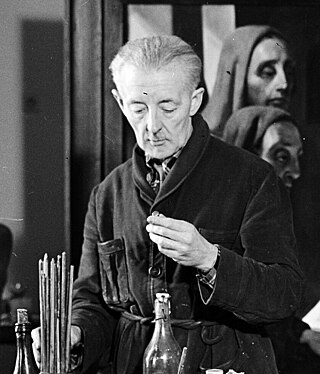
Henricus Antonius "Han" van Meegeren was a Dutch painter and portraitist, considered one of the most ingenious art forgers of the 20th century. Van Meegeren became a national hero after World War II when it was revealed that he had sold a forged painting to Reichsmarschall Hermann Göring during the Nazi occupation of the Netherlands.

Art forgery is the creation and sale of works of art which are falsely credited to other, usually more famous artists. Art forgery can be extremely lucrative, but modern dating and analysis techniques have made the identification of forged artwork much simpler.
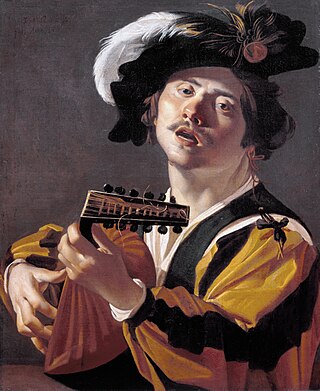
Dirck Jaspersz. van Baburen was a Dutch painter and one of the Utrecht Caravaggisti.

The Caravaggisti were stylistic followers of the late 16th-century Italian Baroque painter Caravaggio. His influence on the new Baroque style that eventually emerged from Mannerism was profound. Caravaggio never established a workshop as most other painters did, and thus had no school to spread his techniques. Nor did he ever set out his underlying philosophical approach to art, the psychological realism which can only be deduced from his surviving work. But it can be seen directly or indirectly in the work of Rubens, Jusepe de Ribera, Bernini, and Rembrandt. Famous while he lived, Caravaggio himself was forgotten almost immediately after his death. Many of his paintings were re-ascribed to his followers, such as The Taking of Christ, which was attributed to the Dutch painter Gerrit van Honthorst until 1990.

Gerard van Honthorst was a Dutch Golden Age painter who became known for his depiction of artificially lit scenes, eventually receiving the nickname Gherardo delle Notti. Early in his career he visited Rome, where he had great success painting in a style influenced by Caravaggio. Following his return to the Netherlands he became a leading portrait painter. Van Honthorst's contemporaries included Utrecht painters Hendrick Ter Brugghen and Dirck van Baburen.
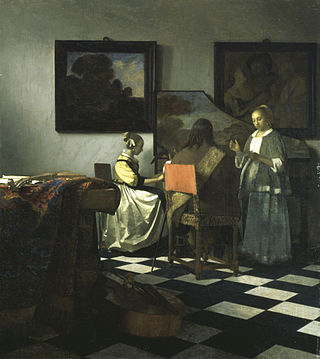
The Concert is a painting by the Dutch artist Johannes Vermeer depicting a man and two women performing music. It was stolen on March 18, 1990, from the Isabella Stewart Gardner Museum in Boston and remains missing. Experts believe it may be the most valuable stolen object in the world; as of 2015, it was valued at US$250 million.

Frederik Hendrik Kreuger, was a Dutch high voltage scientist and inventor, lived in Delft, the Netherlands, and was professor emeritus of the Delft University of Technology. He was also a professional author of technical literature, nonfiction books, thrillers and a decisive biography of the master forger Han van Meegeren.
Geoffrey Fairbank Webb CBE was a British art historian, Slade Professor of Fine Art and head of the Monuments and Fine Arts section of the Allied Control Commission during World War II.
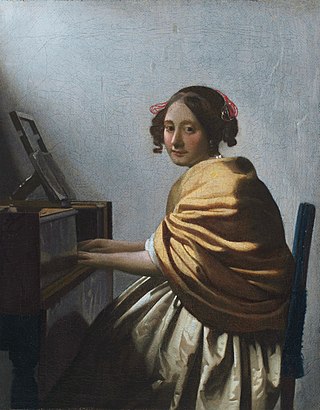
A Young Woman Seated at the Virginals is a painting today attributed to Johannes Vermeer, though this was for a long time widely questioned. A series of technical examinations from 1993 onwards confirm the attribution. It is thought to date from c.1670 and is now in part of the Leiden Collection in New York. It should not be confused with Young Woman Seated at a Virginal in the National Gallery, London, also by Vermeer.
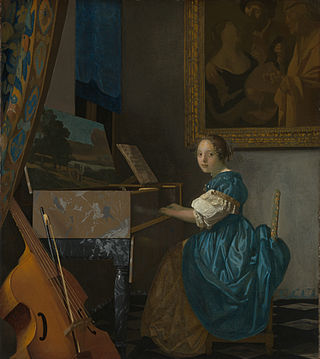
Lady Seated at a Virginal, also known as Young Woman Seated at a Virginal, is a genre painting created by the Dutch Golden Age painter Johannes Vermeer in about 1670–1672 and now in the National Gallery, London.

Jacques Henri Emil van Meegeren was a Dutch illustrator and painter.

Dirk Hannema was a controversial museum director and art collector. The Museum Boijmans flourished under his directorship, but he was also arrested and interned for eight months for his conduct during the German occupation of the Netherlands during World War II. Further, his reputation was severely damaged when he inaccurately attributed various forgeries to the painter Johannes Vermeer, among others. However, a quarter century after his death, he was at least partially vindicated when Le Blute-Fin Mill, a painting he had championed as a van Gogh, was finally authenticated as being by the renowned painter.

The Procuress is a 1656 oil-on-canvas painting by the then 24-year-old Johannes Vermeer. It can be seen in the Gemäldegalerie Alte Meister in Dresden. It is his first genre painting and shows a scene of contemporary life, an image of mercenary love perhaps in a brothel. It differs from his earlier biblical and mythological scenes. It is one of only three paintings Vermeer signed and dated. In 1696 the painting, being sold on an auction in Amsterdam, was named "A merry company in a room".

Theo van Wijngaarden was a Dutch art forger.

Aviva Ruth Burnstock is head of the Department of Art Conservation & Technology at the Courtauld Institute, London. Professor Burnstock is a graduate of the University of Sussex and took in 1991 a PhD at the Courtauld Institute

The Lute Player is an oil-on-canvas painting from 1623 or 1624 now in the Louvre by the Haarlem painter Frans Hals, showing a smiling actor wearing a jester's costume and playing a lute.

The Smiling Girl, thought to be by Johannes Vermeer, was donated by collector Andrew W. Mellon in 1937 to the National Gallery of Art in Washington, D.C. Now widely considered to be a fake, the painting was claimed by the Vermeer expert Arthur K. Wheelock Jr. in a 1995 study to be by a 20th-century artist and forger, Theo van Wijngaarden, a friend of Han van Meegeren.

The Matchmaker or The Procuress is an oil on panel painting by Dutch artist Gerard van Honthorst, created in 1625, now in the Centraal Museum in Utrecht, for which it was bought in 1951 by the Vereniging Rembrandt.

Johannes Vermeer was a Dutch Baroque Period painter who specialized in domestic interior scenes of middle class life. His works have been a common theme in literature and films in popular culture since the rediscovery of his works by 20th century art scholars.




















